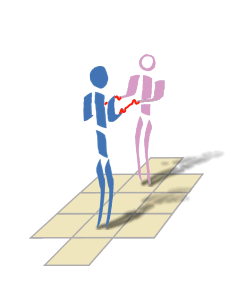Leading and following does not come naturally to new dancers. The following exercise should help get the right feel. Unlike most of the following exercises it applies to all dances.
Take your partner in a double hand-hold (actually a single hand
hold will also work but is slightly more difficult to start with). Man's hands are
best to be palms upward, lady's hands draped over the man's, although this does not
matter for the exercise. Ensure both your arms are bent at the elbows.
Check that you are neither pressing into each other nor pulling apart.

Now the man just starts walking forwards (ie lady backwards). It does not matter which foot the man or lady starts with for this exercise, although mirroring looks better and is less likely to result in one of you being kicked!
You will notice a slight tug when the man starts to move. This is natural and essential. During this tug it is quite acceptable to allow your elbows to bend slightly for the duration but they must revert once you are moving. However neither of you should let them bend such that the pressure of the lead is relaxed otherwise the lady will not move! Ladies - if he does not lead, do not move!
It can be helpful for the lady to imagine that she is strapped with a bomb on her back and a sensor measuring the distance from the leader. If this becomes too great then it will explode. Additionally, there is a "jerk sensor" which will trigger the bomb if she jerks too much.
Now the man changes direction (not too suddenly) and walks backwards (lady forwards).
Now the man leads walking forwards then backwards, indeed with two arms one can even steer! The man should try to "catch out" the lady just in case she is trying to use intuition and predict which way he is going to go.
Now blind-fold the lady and repeat! This ensures that she really does it from the feel and not the direction of his body. Sometimes a lead may push the lady backwards when he is walking forwards (ie a promenade), sometimes he may push her backwards when he is walking away from her to build up tension. This is an exercise coming up later.
The man has to learn to be positive and keep his arms from being floppy in a horizontal plane or he will lose the lead. The lady has to learn to react to a pull or a push with a compensating force to correct the attempted movement on her elbows. By ensuring her elbows do not change angle (or her shoulders droop in, or her back bends), she allows the man's lead on her hands to be projected right through her arms to her body.
Now repeat but the man should try to raise and lower his arms and the lady should allow this to occur easily whilst his movement horizontally should feel well connected to her body. This vertical independence is necessary to allow a man to lead turns. Tell the lady if her hands feel heavy when raised - they should not.

Now assume a similar position but put your hands in a palm to palm hold and allow your bodies to tilt slightly to maintain a steady pressure between your hands. Try moving forwards and backwards. At first it will be hard for the lady to maintain a pressure when she is lead forwards. One good trick is to place a coin between each palm and ensure it does not drop out!

Assume a similar position but take two ties (or similar) and grasp either end of each in your hands and tilt your bodies so you maintain a tension between you keeping the handkerchiefs taught. Try again moving forwards and backwards maintaining the tension. It is possible to perform this exercise without such props and a loose hand-grip, but it is harder to see if you are in fact using pressure rather than tension.
This is only for intermediates! Revert to the normal handgrip and start with normal walking forwards, then backwards, then forwards then backwards. Immediately follow this with a repetition of the same lead on the lady (ie push, pull, push, pull) but than man walks in the opposite direction (ie backwards, forwards, backwards forwards). To do this the man will have to allow his elbows to extend (but try not to end up with completely straight arms). Try to follow with a reversion back to the original motion. This may be best done with the lady blindfolded as we are trying to get her to be lead with the hands independently from the motion of your body that she can see.
Now put it all together and try adding promenades onto your favourite beginner moves. For instance perform a first move, turning the lady out and then back, but instead of turning her CW then ACW, immediately walk forwards for 4 beats then backwards for 4 beats, then finish. It will be a shock for a lady the first time as they will assume they know what is about to occur! This can only be done with a positive lead.
The lady goes where the man leads. If he does not lead she goes nowhere. Well it's often worse than that; she actually goes where she thinks she ought without a great deal of information! The man should be able to lead a lady's motion in any direction, whatever his own body is doing. The lady should allow the man's hands to move her whole body. Floppy arms and limp lettuce bodies, backs bending etc should be a thing of the past.